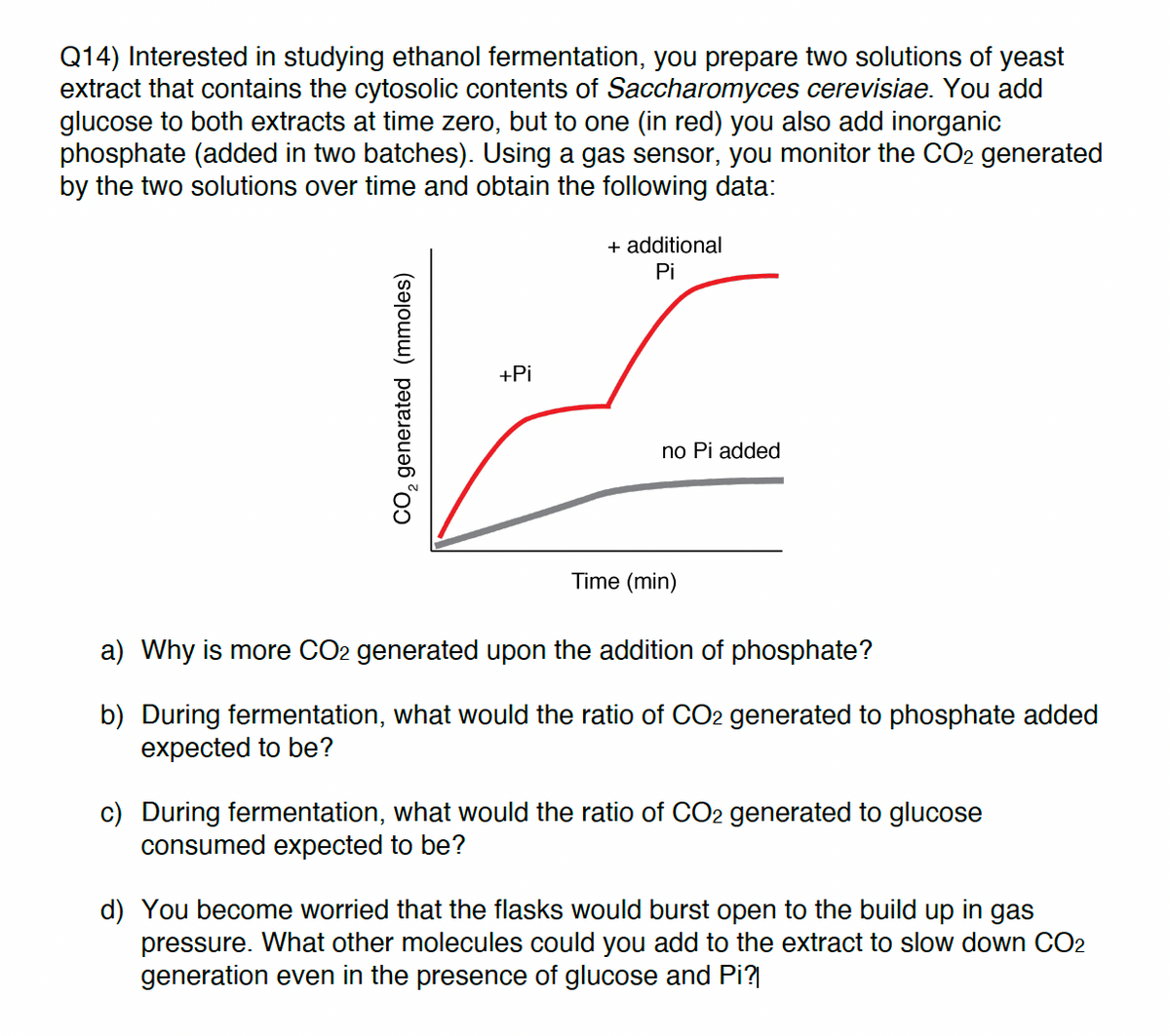Q14) Interested in studying ethanol fermentation, you prepare two solutions of yeast extract that contains the cytosolic contents of Saccharomyces cerevisiae. You add glucose to both extracts at time zero, but to one (in red) you also add inorganic phosphate (added in two batches). Using a gas sensor, you monitor the CO2 generated by the two solutions over time and obtain the following data:
Q14) Interested in studying ethanol fermentation, you prepare two solutions of yeast extract that contains the cytosolic contents of Saccharomyces cerevisiae. You add glucose to both extracts at time zero, but to one (in red) you also add inorganic phosphate (added in two batches). Using a gas sensor, you monitor the CO2 generated by the two solutions over time and obtain the following data:
Chemistry
10th Edition
ISBN:9781305957404
Author:Steven S. Zumdahl, Susan A. Zumdahl, Donald J. DeCoste
Publisher:Steven S. Zumdahl, Susan A. Zumdahl, Donald J. DeCoste
Chapter1: Chemical Foundations
Section: Chapter Questions
Problem 1RQ: Define and explain the differences between the following terms. a. law and theory b. theory and...
Related questions
Question
PLEASE HELP ME.

Transcribed Image Text:Q14) Interested in studying ethanol fermentation, you prepare two solutions of yeast
extract that contains the cytosolic contents of Saccharomyces cerevisiae. You add
glucose to both extracts at time zero, but to one (in red) you also add inorganic
phosphate (added in two batches). Using a gas sensor, you monitor the CO2 generated
by the two solutions over time and obtain the following data:
+ additional
Pi
+Pi
no Pi added
Time (min)
a) Why is more CO2 generated upon the addition of phosphate?
b) During fermentation, what would the ratio of CO2 generated to phosphate added
expected to be?
c) During fermentation, what would the ratio of CO2 generated to glucose
consumed expected to be?
d) You become worried that the flasks would burst open to the build up in gas
pressure. What other molecules could you add to the extract to slow down CO2
generation even in the presence of glucose and Pi?
CO, generated (mmoles)
Expert Solution
This question has been solved!
Explore an expertly crafted, step-by-step solution for a thorough understanding of key concepts.
This is a popular solution!
Trending now
This is a popular solution!
Step by step
Solved in 2 steps with 2 images

Knowledge Booster
Learn more about
Need a deep-dive on the concept behind this application? Look no further. Learn more about this topic, chemistry and related others by exploring similar questions and additional content below.Recommended textbooks for you

Chemistry
Chemistry
ISBN:
9781305957404
Author:
Steven S. Zumdahl, Susan A. Zumdahl, Donald J. DeCoste
Publisher:
Cengage Learning

Chemistry
Chemistry
ISBN:
9781259911156
Author:
Raymond Chang Dr., Jason Overby Professor
Publisher:
McGraw-Hill Education

Principles of Instrumental Analysis
Chemistry
ISBN:
9781305577213
Author:
Douglas A. Skoog, F. James Holler, Stanley R. Crouch
Publisher:
Cengage Learning

Chemistry
Chemistry
ISBN:
9781305957404
Author:
Steven S. Zumdahl, Susan A. Zumdahl, Donald J. DeCoste
Publisher:
Cengage Learning

Chemistry
Chemistry
ISBN:
9781259911156
Author:
Raymond Chang Dr., Jason Overby Professor
Publisher:
McGraw-Hill Education

Principles of Instrumental Analysis
Chemistry
ISBN:
9781305577213
Author:
Douglas A. Skoog, F. James Holler, Stanley R. Crouch
Publisher:
Cengage Learning

Organic Chemistry
Chemistry
ISBN:
9780078021558
Author:
Janice Gorzynski Smith Dr.
Publisher:
McGraw-Hill Education

Chemistry: Principles and Reactions
Chemistry
ISBN:
9781305079373
Author:
William L. Masterton, Cecile N. Hurley
Publisher:
Cengage Learning

Elementary Principles of Chemical Processes, Bind…
Chemistry
ISBN:
9781118431221
Author:
Richard M. Felder, Ronald W. Rousseau, Lisa G. Bullard
Publisher:
WILEY